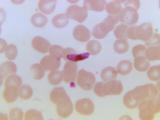Sep 17, 2012
Flu antibody's precision targeting may spur new treatments, vaccines
Scientists report that they have mapped the structure of a human antibody that zeroes in on the precise part of the flu virus's hemagglutinin protein that latches onto host cells, a finding that they say may spur the quest for new flu treatments and a broadly protective flu vaccine. Researchers from the Scripps Research Institute and Sea Lane Biotechnologies found the antibody, called C05, by screening billions of antibodies generated from the bone marrow of patients who had been exposed to certain flu strains, says a Scripps press release. The team found that the antibody could bind to proteins from a variety of influenza A viruses, including subtypes H1, H2, H3, and H9. In addition, C05 protected cells in lab cultures from these viruses, prevented infections in mice, and "rescued" mice when used as post-infection treatment. C05 is "almost unique" among broadly neutralizing flu antibodies in that it specifically recognizes and blocks the receptor-binding site (RBS) on the head of the hemagglutinin molecule, the release says. The RBS changes little from strain to strain, whereas the surrounding structures vary. Using x-ray crystallography and other methods, the scientists determined that C05 avoids grabbing the variable regions around the flu RBS. "Instead it uses a single elongated protein loop to reach in and make a 'one-handed'—or 'one-fingered'—grab of the RBS itself," the release says. "The antibody apparently works best when two of these active loops, one on each arm, grab two viral RBSs on separate hemagglutinins." This precision targeting suggests that C05 could contribute to antibody-based therapies for severe flu infections, the statement said. In addition, a universal flu vaccine might be more effective if it could be designed to elicit such antibodies.
Sep 16 Nature report
Sep 16 Scripps press release
Flu-malaria co-infection not uncommon in Kenyan preschoolers
About 5% of Kenyan children under 5 years old who contracted influenza or malaria were co-infected with the other disease, which tended to increase hospitalization time, a study in the Journal of Infectious Diseases found. Researchers from Kenya and the US Centers for Disease Control and Prevention (CDC) analyzed data on flu and malaria infections confirmed from July 2009 through June 2011 in Kenyan kids under 5 at two rural sites. They found that 45.0% (149/331) of influenza patients were co-infected with malaria, while only 6.2% (149/2408) of malaria-positive patients were co-infected with flu. The overall rate of co-infection was 5.4% (149/2,739). The team found that children with influenza were less likely than those without to have malaria (risk ratios [RRs], 0.57-0.76), and kids with malaria were less likely than those without to have flu (RRs, 0.36-0.63). The length of hospital stay for co-infected children was 2.7 and 2.8 days longer than for flu-only infected children at the two sites, and 1.3 and 3.1 days longer than for those with only malaria, both of which were significant differences.
Sep 14 J Infect Dis abstract
Second plague case connected to infected Oregon cat
Health officials in Oregon's Crook County said a second plague infection has been linked to an incident in June when a man was infected after he was bitten while attempting to remove a mouse from a cat's mouth, according to a Sep 14 Oregonian story. Karen Yeargain, LPN, Crook County's communicable disease coordinator, told the paper that CDC lab tests confirmed that a woman also involved in the incident had been infected with plague, as well. She was treated with antibiotics and didn't become seriously ill. However, the man had a serious infection, was hospitalized in intensive care for a month, and lost his fingers and toes. The woman had been living with the man's family and was also bitten when they were trying to take the mouse out of the cat's mouth. Emilio DeBess, DVM, Oregon's state public health veterinarian, said in July that CDC testing confirmed that the man's cat was infected with Yersinia pestis, which causes plague and is typically spread by the bite of an infected flea.
Sep 14 Oregonian story
Jun 13 CIDRAP News Scan "Oregon man critical with suspected plague infection"
CIDRAP plague overview
Saudi polio expert urges Taliban to lift ban
Saudi Arabia's former health minister in a recent visit to Pakistan appealed to Taliban leaders to lift their ban on polio vaccination, The News International, a newspaper based in Karachi, reported today. In a meeting with journalists in Peshawar yesterday, Dr Hussain Gezairy put out a call to the Taliban's senior leaders to lift the ban for the benefit of future generations and the rest of the world and to keep health matters separate from other issues. He added that the same vaccine has been used to eradicate polio from most of the Muslim world, including Saudi Arabia. Gezairy complimented the work some of Pakistan's banned militant organization have done to support polio immunization. Two such groups recently allowed government immunizers access to children in the Tirah valley of the volatile Khyber Agency. The Taliban has barred polio vaccination in parts of Pakistan to protest recent US drone strikes. Gezairy is an advisor to the World Health Organization on polio eradication issues.
Sep 17 News International story


















